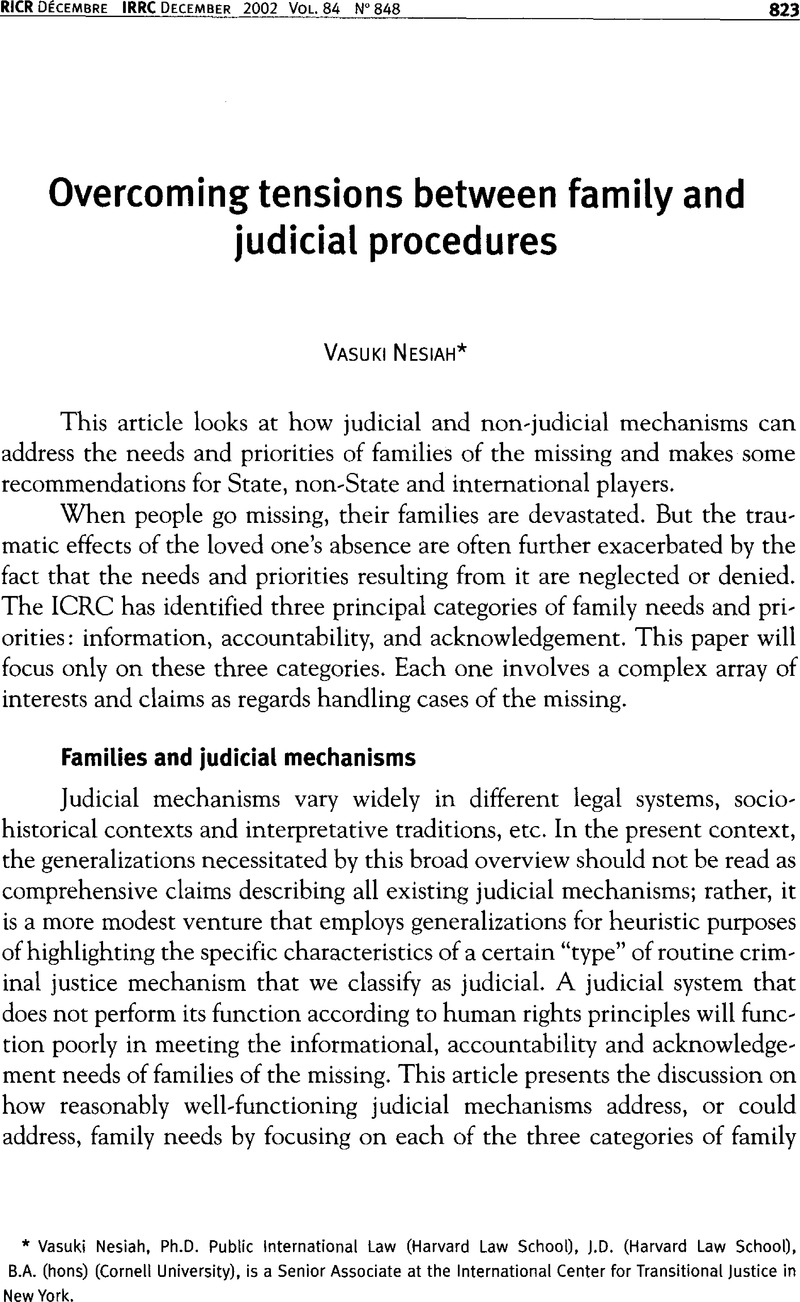Article contents
Overcoming tensions between family and judicial procedures
Published online by Cambridge University Press: 19 April 2010
Abstract

- Type
- Research Article
- Information
- International Review of the Red Cross , Volume 84 , Issue 848: Missing persons/Personnes disparues , December 2002 , pp. 823 - 844
- Copyright
- Copyright © International Committee of the Red Cross 2002
References
1 In South Africa, the Amnesty Committee of the TRC was given the power to grant amnesty to individual perpetrators if they made full disclosure. An amnesty applicant was required to appear before the Committee in a public hearing, unless the act in question did not involve a gross violation of human rights. See Promotion of National Unity and Reconciliation Act, 26 07, 1995Google Scholar, Article 19(3)(b)(iii).
2 Gathering information on the fate of the disappeared was the primary mandate of the truth commission Argentina, the Argentine National Commission on Disappeared Persons (CONADEP). “The Commission took over 7,000 statements over nine months' time, documenting over 8,960 persons who had disappeared.” Hayner, Priscilla, Unspeakable Truths, Routledge, New York, 2001, p. 34Google Scholar. See also Nunca Mas: Report of the Argentinian Commission on the Disappeared, 09 1984Google Scholar. Similarly, in Chile, the second volume of the Commission's report “lists the names of the victims and provides personal information, including any known circumstances related to their disappearance or death”. Jo M. Pasqualucci, “The whole truth and nothing but the truth: Truth commissions, impunity and the inter-American human rights system”, Boston University International Law Journal, Vol. 2, 1994, p. 339.Google Scholar
3 The South African TRC was mandated to “facilitate, and initiate or co-ordinate, the gathering of information(…) [in order] to establish the identity of victims of [past] violations, their fate or present whereabouts.” South African Truth and Reconciliation Commission Final Report, Vol. 1Google Scholar, Ch. 4, para. 31.
4 In South Africa, the NGO Coalition on the TRC coordinated information held by human rights organizations in South Africa and internationally even before the TRC begun its proceedings; the Coalition then handed over their records of human rights violations to the TRC to be incorporated in a national database. See Hugo van der Merwe et al., “Nongovernmental organizations and the Truth and Reconciliation Commission: An impact assessment,” http://www.csvr.org.za/papers/paphvp&b.htm, p. 12 and footnote 23 on p. 30.
5 In accordance with the partnership, the ICRC will give the Peruvian Truth Commission generic information (not dossiers on individuals per se) on about 430 cases that do not figure in any database so far. There will then be a public campaign to verify this information and request more; ICRC delegates will work in local communities to urge people to come forward with further information. The project includes a systematic compilation of the ICRC's experience in the search for individuals and the creation of a single list of disappeared.
6 “Basic principles and guidelines on the right to reparation for victims of gross violations of human rights and humanitarian law”, Annex, “Revised set of basic principles and guidelines on the right to reparation for victims of gross violations of human rights and humanitarian law”, prepared by Mr Theo van Boven pursuant to Sub-Commission decision, 1995/117, UN Doc. E/CN.4/Sub.2/1996/17, 24 May 1996, para. 7.
7 Ibid., para. 15.
8 The Argentinian Courts have developed an interesting jurisprudence on the right to truth. Notwithstanding the 1987 laws (the “Full-stop law” and the “Due obedience law”) seeking to curtail prosecutorial investigation into past human rights crimes, in the mid-1990s families of the disappeared successfully petitioned courts to recognize that victims had a right to truth which the State should take proactive measures to address. Courts recognized that victims needed closure and the ability to mourn their dead and that “the state had an unquestionable obligation to use legal means to reconstruct the past in order to discover facts and thereby give a response to family members and to society.” Popkin, Margaret et al. “Latin American amnesties in comparative perspective”, Ethics and International Affairs, Vol. 13, 1999, p. 109.CrossRefGoogle Scholar
9 Ibid.
10 Some groups representing victim families in Argentina, most notably Las Madres de la Plaza de Mayo, denounce State reparations and instead demand full disclosure of the fate of their loved ones. However, the majority of families of the disappeared and former political prisoners have accepted the reparations. Hayner, Priscilla, Unspeakable Truths, Routledge, New York, 2001, pp. 177–178 and pp. 330–331.Google Scholar
- 2
- Cited by




